Yet, like much of colonial Lima, it has had a storied history that belies its current circumstances.
More importantly, for lovers of traditional Peruvian food, every Sunday there is a Peruvian food festival that is set up in the Plaza Italia, offering a smorgasbord of traditional dishes to be eaten at small tables while watching passers-by traipse through what is one of Lima's most ancient public squares.
The Plaza Italia is located between Jirón Junín and Jirón Huallaga, at the intersection of Jirón Huanta.
 Photo: Plaza Italia.
Photo: Plaza Italia.I confess I do not recall where I obtained this photo;
if it's yours, let me know .
Prior to the arrival of the Spanish, where the Plaza Italia is now located was the site of a very important huaca, or ceremonial temple, which housed an oracle, second in importance in the region only after Pachacámac.
This oracle was so beloved by the local people, the Spanish felt they had to destroy it and build a plaza in its stead. The new plaza was shaped like a trapezoid, in keeping with pre-Columbian design, which is why today's Plaza Italia is unlike other colonial plazas in Peru, which tend to be square or rectangular.
The huaca was also an important pre-Columbian crossroads, with the Inca highway to the Andes passing through the vicinity of what is now the Plaza Italia.
During the early colonial period, this plaza was also one of the boundaries of Lima.
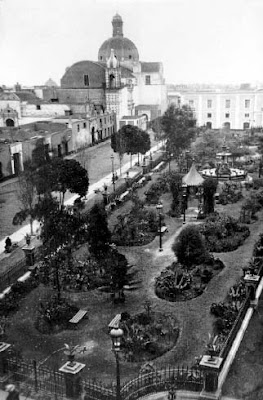 Photo: Plaza Santa Ana, 1800s.
Photo: Plaza Santa Ana, 1800s.Universidad Nacional de San Marcos.
By 1550, a church named after Saint Anne was built on a corner of the plaza. The Iglesia de Santa Ana still stands to this day, although it has long lost its colonial glory. For centuries the plaza was known as Plaza de Santa Ana.
In 1550, one of the first hospitals in colonial Peru, the Real Hospital de Santa Ana, or Royal Santa Ana Hospital, was moved to a location facing the plaza. During the colonial period, this hospital only treated indigenous people, but at Independence in 1821, it became a general hospital. Eventually, the hospital was moved a few blocks away, where the current Hospital de Maternidad, or Maternity Hospital, still stands.
In 1811, the Faculty of Medicine and Surgery of San Fernando, Colegio de Medicina y Cirugía de San Fernando, also opened its doors facing the plaza.
 Photo: Plaza Santa Ana, 1800s.
Photo: Plaza Santa Ana, 1800s.Biblioteca Nacional del Perú.
The Plaza de Santa Ana was also the site of some of the earliest movie theaters in Lima, now long-abandoned and converted into parking lots or evangelical churches. The two theaters that functioned well into the 1980s were the Francisco Pizarro and the Mazzi.
During the early 1900s (I've been trying to find the exact date to no avail), the Plaza Santa Ana was renamed Plaza Italia, in honor of the many Italian immigrants who arrived in Peru from the late 1800s to the early 1900s.
In particular, it was meant to honor Milan-born Antonio Raimondi, who became a prominent geographer and scientist in his adopted homeland.
 Photo: Antonio Raimondi, Wikipedia.
Photo: Antonio Raimondi, Wikipedia.Antonio Raimondi emigrated to Peru in 1850 and became a professor of natural history. Later, he became one of the founding professors of the medical school at the University of San Marcos.
Throughout his career, he displayed a passion for all things Peruvian. He undertook no less than 18 extensive journeys to all regions of the country, studying the nation's geography, geology, botany, zoology, ethnography, and archaeology.
In 1875, he collected his findings in the massive tome he called simply, El Perú. There is a statue in honor of Antonio Raimondi in the Plaza Italia.
 Photo: El Perú by Antonio Raimondi, Wikipedia.
Photo: El Perú by Antonio Raimondi, Wikipedia.But, as often happens, I digress. This is a blog about Peruvian food; so, let me whet your appetites with some photos I took the last time I was in Lima of the Feria de Comida Criolla held every Sunday in Plaza de Italia.
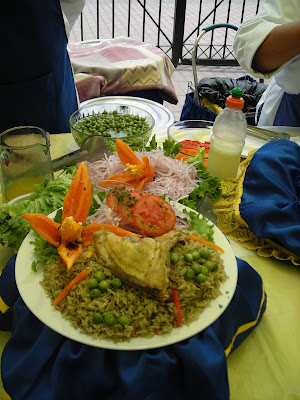
Arroz con pato, duck in seasoned rice.

Cuy with frejoles and rice.
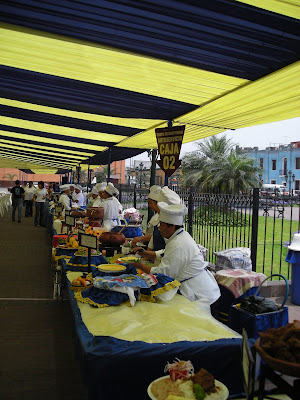
A view of the vendors, nice ladies from the neighborhood who cook early in the morning and serve all day.
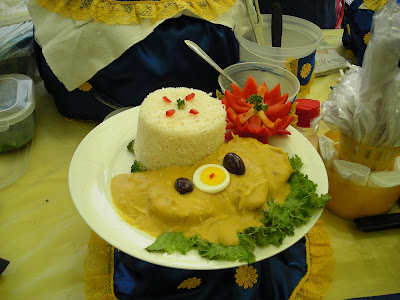
Ají de gallina, chicken in a spicy creamy sauce.
(Gracias por la correción.)
(Gracias por la correción.)
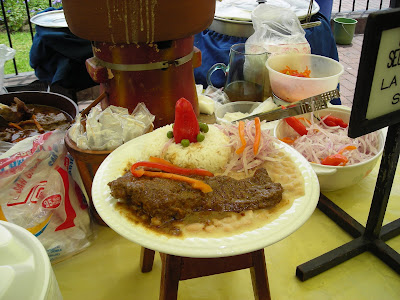
Seco de res, beef in a cilantro-based sauce.
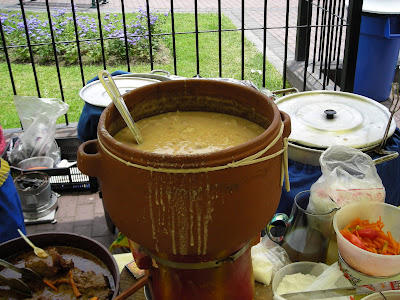
A pot of bubbling frejoles, Peruvian beans.
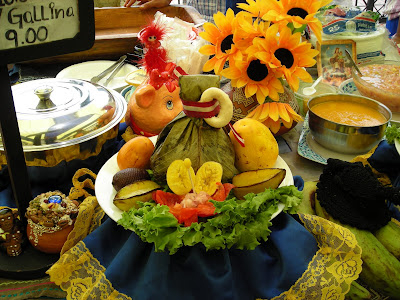
Juanes from the Amazon, similar to a tamal, stuffed with rice and chicken.
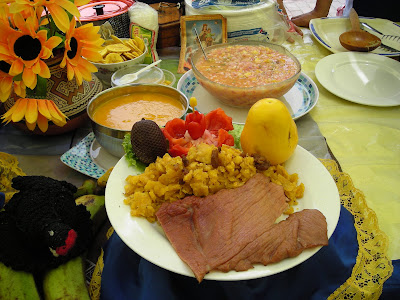
Cecina from the Amazon, salted beef served with tacacho, a banana-based accompaniment.
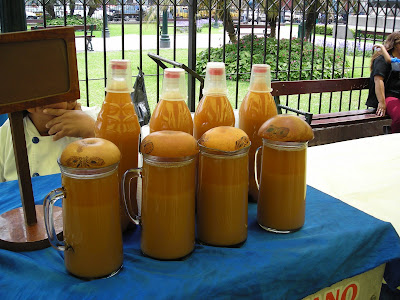
Chicha de jora, an ancient corn-based frothy drink.
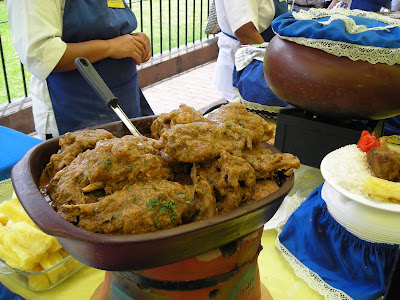
Estofado de carnero, lamb stew.
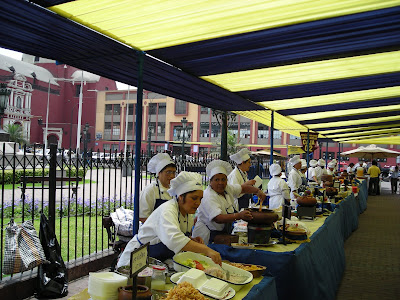
Another view of the friendly ladies at the Feria de la Cocina Criolla.
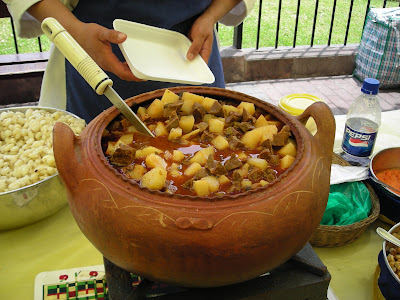
Chanfainita, a spicy pork and potato dish.
(Gracias por la aclaración.)
(Gracias por la aclaración.)
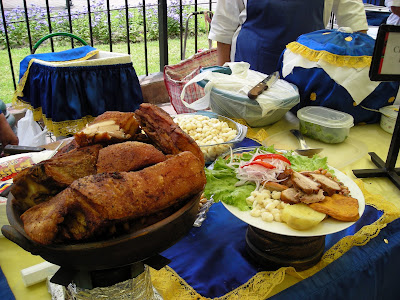
Chicharrón de chancho, fried pork served with salad and potatoes.
A word of caution: This is a very busy area in central Lima and care should be exercised. Also, the Plaza Italia should be the boundary of a tourist's visit to the Barrios Altos, the district where Plaza Italia is located. Sadly, going beyond the Plaza Italia (away from central Lima), the area becomes dangerous. Please do not go beyond Jirón Huanta. The plaza itself is safe, since there is a police station which abuts it.
Peru.Food@gmail.com
.
.
.
Click here for the Peru Food main page.
TAGS: Peru, Peruvian, food, cooking, cuisine, cocina, comida, gastronomía, peruana
TAGS: Peru, Peruvian, food, cooking, cuisine, cocina, comida, gastronomía, peruana
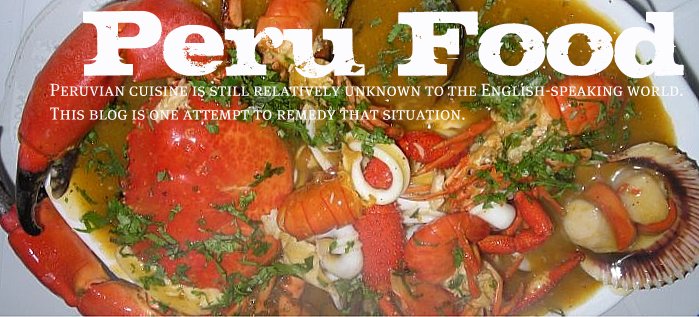
4 comments:
Everything looks delicious, clean and well done. I don't get to see this kind of presentation in the US but in very expensive restaurants. This food festival must be very popular!
Felicitaciones por el artìculo! ... y al solo ver los platos me da hambre!! Ciao de Italia!!!!!!!!!!!!!!!!!!!!!!!!!!!
Beautful pictures! I'm hungry ...
So glad that you all liked this post! Come again!
Post a Comment